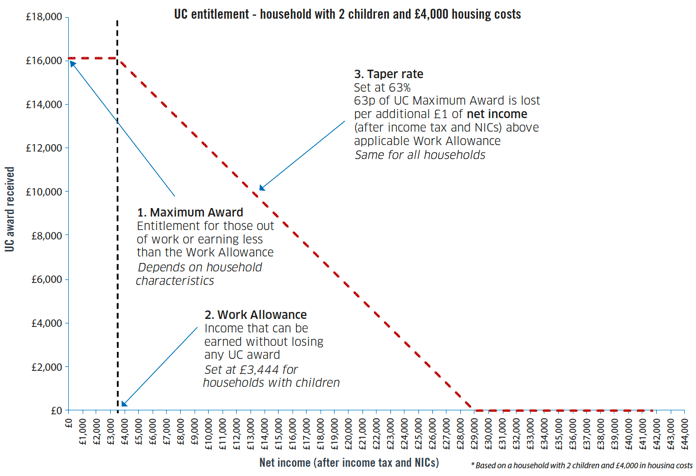Income supplement: analysis of options
Analysis undertaken to inform the development of the income supplement policy, a flagship commitment in our Tackling Child Poverty Delivery Plan for 2018-2022.
This document is part of a collection
Annex I: Universal Credit
The level of Universal Credit that a household is entitled to is calculated by adding together its various elements to establish the Maximum Award and then reducing (tapering) this award in line with the household's earned income. For households with children, the award is only tapered once income reaches a set level called the Work Allowance.
UC Maximum Award. The three main elements are the Standard Element, Child Element and Housing Element.[67] The level of Standard Element depends on whether the household is made up of a) a single person or a couple and b) adults aged under 25 or 25 or older. The Child Element is then added for each child, with the First Child Element being higher than for subsequent children. From April 2017, the Child Element will be limited to 2 children and the payment for the first child will be lowered to that for subsequent children. This will apply to new claims only. Eligible housing costs, which are within the Local Housing Allowances, are added to this amount as Housing Element.
UC Work Allowances and Tapering. If a household's income exceeds a certain amount – called the Work Allowance – the Maximum Award is reduced at a set taper rate. This is currently set to 63% and means that for each additional £1 of net income above the Work Allowance, the UC Maximum Award is reduced by 63p. Net income refers to earned income (from employment or other sources) after labour taxes, i.e. income tax and employee's National Insurance contributions. There are two Work Allowance levels, depending on whether the household receives the Housing Element. Households without children, or a health condition that affects their ability to work, do not have a Work Allowance.
The figure below illustrates the annual UC entitlement for a household at different levels of net (after income tax and NICs) earned income. For this particular household made up of a couple with 2 children with £4,000 in annual housing costs, the Maximum Award is £16,092. This is made up of £5,987 in Standard Allowance, £3,325 and £2,780 for the first and second child respectively and £4,000 in housing costs. As shown in the chart, this Maximum Award does not start to taper until the net household income reaches £3,444 a year – the Work Allowance for a couple with children with housing costs. At incomes beyond this point, each additional £1 of net income reduces the UC Maximum Award by 63p. This particular household would not receive any UC at annual net income above £28,998. This corresponds to annual gross earned income (before taxes and NICs) of around £37,600.
Figure A1: Universal Credit means-testing parameters

Contact
Email: vana.anastasiadou@gov.scot
There is a problem
Thanks for your feedback